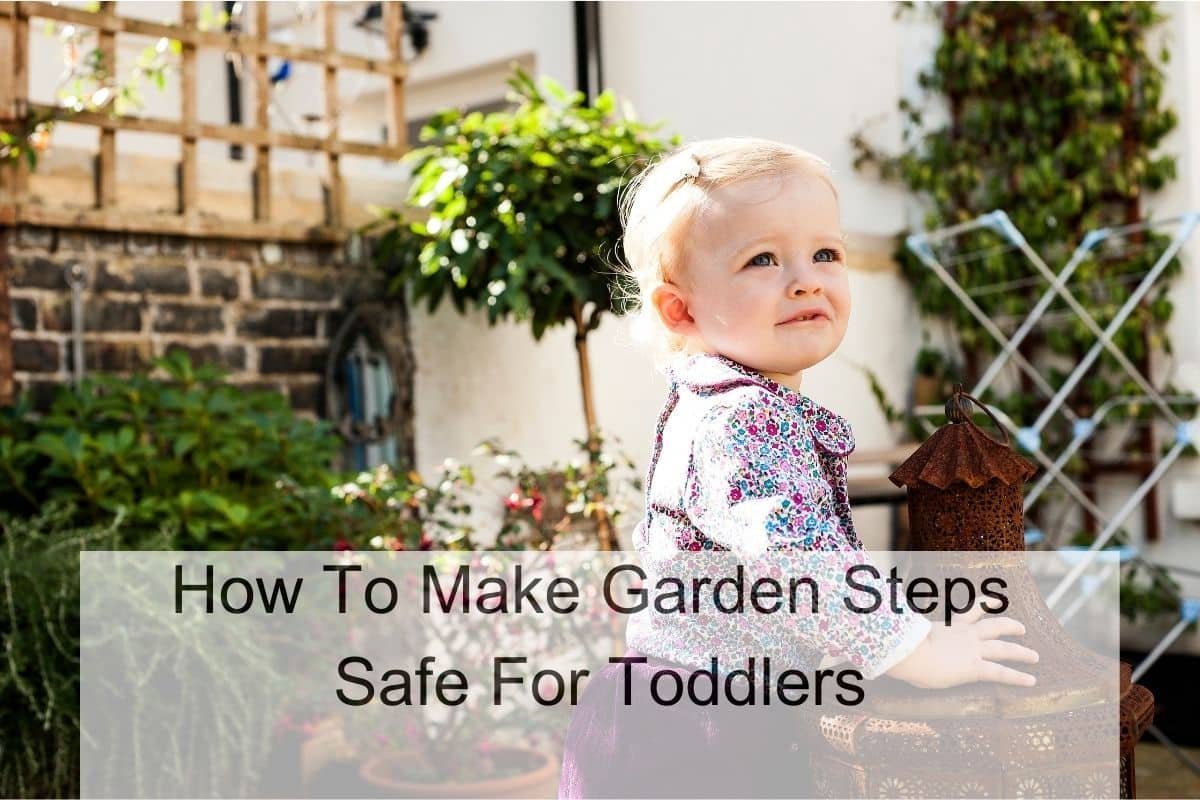Gardening is an excellent way to get outside and enjoy nature. However, it can be challenging to keep your garden safe for your little ones. Garden steps can be especially hazardous for toddlers, who may not yet have the coordination to navigate them safely. As a gardener and a parent, I have found several effective strategies for making garden steps safe for toddlers.

The first step is to choose the right material for your garden steps. Some materials are more slippery than others, increasing the risk of falls. For example, concrete is often more slippery than brick or stone. Additionally, consider adding anti-slip tape or applying a non-slip sealer/paint to the surface of the steps. These simple measures can go a long way in preventing accidents.
Assessing Your Garden’s Layout

As a parent, the safety of your child is of utmost importance, and this is especially true when it comes to your garden. Before making any changes to your garden steps, it is important to assess your garden’s layout. This will help you identify potential hazards and determine what changes need to be made to ensure your child’s safety.
Evaluating Existing Steps
The first step in assessing your garden’s layout is to evaluate any existing steps. Check to see if they are stable and secure. Loose or wobbly steps can be a tripping hazard for toddlers. If you find any steps that are unstable, secure them by adding brackets or screws. You can also replace any damaged steps with new ones.
It is also important to check the surface of the steps. Smooth surfaces can be slippery, especially when wet. To improve traction, consider adding non-slip treads or grip tape to the steps. These can be found at your local hardware store.
Identifying Potential Hazards
The next step in assessing your garden’s layout is to identify potential hazards. Look for anything that could pose a danger to your child. For example, if there are steep drops or ledges near the steps, consider adding railings or barriers to prevent falls. If your garden has a pond or other water feature, make sure it is securely fenced off or covered with a wire mesh frame to prevent your child from falling in.
Another potential hazard to look out for is sharp edges or corners. These can be dangerous if your child falls or trips. Consider adding padding or bumpers to any sharp edges to make them safer.
Materials and Tools for Safe Steps

Choosing Non-Slip Materials
When it comes to making garden steps safe for toddlers, choosing the right materials is crucial. Some materials are more slippery than others, increasing the risk of falls. To prevent accidents, I recommend using non-slip materials for your garden steps. Some options include:
- Concrete: Concrete is a durable and slip-resistant material that is perfect for outdoor steps. You can add a non-slip additive to the concrete mix to increase traction.
- Rubber: Rubber is another excellent non-slip material that is perfect for outdoor steps. You can use rubber mats or tiles to cover your steps and provide a safe walking surface for your child.
- Stone: Stone is a natural material that is slip-resistant and provides excellent traction. You can use natural stone or manufactured stone to create safe garden steps for your toddler.
Gathering Necessary Safety Equipment
To make your garden steps safe for toddlers, you will need some safety equipment. Here are some items that I recommend:
- Safety glasses: Safety glasses are essential when working with power tools or cutting materials. They protect your eyes from flying debris and dust.
- Gloves: Gloves protect your hands from cuts, scrapes, and splinters. They also provide a better grip when handling tools.
- Non-slip tape: Non-slip tape is an easy and affordable way to add traction to your garden steps. You can apply it to the surface of the steps to create a non-slip surface.
- Safety shoes: Safety shoes provide extra protection for your feet and toes. They are essential when working with heavy materials or power tools.
Designing Toddler-Friendly Steps

As a parent, safety is always a top priority when it comes to designing a garden that your toddler can safely explore. One of the most important aspects of a toddler-friendly garden is ensuring that your garden steps are safe and secure. Here are a few tips to help you design garden steps that are safe for your little one to use.
Optimal Step Height and Depth
When designing garden steps for toddlers, it is important to consider the height and depth of each step. According to KidsTurnCentral.com, the ideal height for each step is no more than 6 inches, with a depth of 12 inches. This will ensure that your toddler can easily climb up and down the steps without risking a fall.
Incorporating Handrails and Barriers
Handrails and barriers are essential for keeping your toddler safe when using garden steps. Handrails provide extra support and stability, making it easier for your little one to climb up and down the steps. Barriers, such as fences or gates, can also be used to prevent your toddler from accessing the steps without your supervision.
When installing handrails, make sure they are installed at a height that is appropriate for your toddler’s height. According to Better Homes and Gardens, handrails should be installed at a height of 24-26 inches for toddlers.
Construction Tips for Secure Steps

As a parent, I know how important it is to ensure that your garden steps are safe for your toddlers. Here are some construction tips to help you create secure steps:
Ensuring Even Step Surfaces
Uneven step surfaces can be a tripping hazard for toddlers. To ensure even step surfaces, use a level to check that each step is flat. If any step is not level, adjust the height of the step by adding or removing soil. You can also use a level to check that the steps are level with each other.
Securing Edges and Corners
Edges and corners of steps can also be a potential hazard for toddlers. To secure edges and corners, consider adding a non-slip surface to the steps. You can use a stair runner, which is a strip of carpet or rubber that runs along the center of the steps, providing a non-slip surface for your child to walk on. Additionally, make sure that the carpet is secured tightly to the stairs to avoid any tripping hazards.
Another option is to add handrails to the sides of the steps. Handrails provide support for toddlers as they climb up and down the steps. Make sure that the handrails are securely attached to the steps and that they are the appropriate height for your child.
Adding Safety Features
As a parent, I know how important it is to ensure that your garden is a safe place for your little ones to play. Here are two ways to make your garden steps safe for toddlers:
Installing Gates at Step Entrances
One of the easiest ways to make your garden steps safe for toddlers is by installing gates at the entrances to the steps. This will prevent your little ones from accessing the steps without adult supervision. You can install gates that are specifically designed for outdoor use, or you can use indoor gates if they are sturdy enough to withstand outdoor conditions. Make sure that the gates are securely installed and that they cannot be easily opened by your children.
Applying Anti-Slip Treatments to Step Surfaces
Another way to make your garden steps safe for toddlers is by applying anti-slip treatments to the surfaces of the steps. This will prevent your children from slipping and falling on the steps. There are many different types of anti-slip treatments available, including anti-slip tape, non-slip sealer, and non-slip paint. Choose the type of treatment that is best suited for your specific type of steps and apply it according to the manufacturer’s instructions.
Regular Maintenance and Upkeep
As a parent, I know how important it is to ensure the safety of toddlers when they are playing outside, especially when it comes to garden steps. Regular maintenance and upkeep of the steps are crucial for ensuring their safety.
Checking for Wear and Tear
I make it a habit to check the garden steps regularly for any signs of wear and tear. This includes checking for loose or broken steps, cracks in the surface, and any other damage that could pose a safety hazard. If I notice any issues, I take immediate action to fix them.
Scheduling Periodic Safety Inspections
In addition to regular checks, I also schedule periodic safety inspections by a professional. This ensures that the steps are up to code and meet safety standards. During the inspection, the professional will check for any potential hazards and make recommendations for improvements.
Educational Tips for Toddlers
As a parent, I want to make sure my toddler is safe while exploring the garden. Here are some educational tips to teach toddlers how to navigate garden steps safely.
Teaching Safe Step Navigation
First, I want to make sure my toddler knows how to navigate garden steps safely. I will teach them to step on the center of each step and hold onto the handrail. I will also show them how to look down and watch their step while going up or down the stairs.
To reinforce this, I will use visual aids such as pictures and videos. I will also use positive reinforcement by praising them when they follow the rules and giving them a small reward such as a sticker or a high five.
Supervised Practice Sessions
Once my toddler knows the rules of safe step navigation, I will supervise them during practice sessions. I will stand behind them and hold onto their waist while they go up and down the stairs.
During these sessions, I will also point out any potential hazards such as loose rocks or slippery steps. This will help my toddler learn how to identify and avoid potential hazards in the garden.

